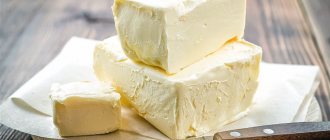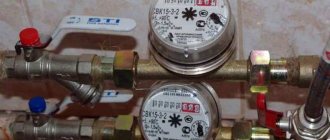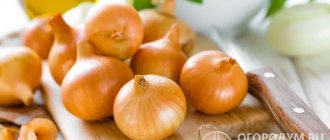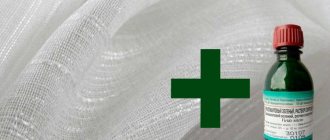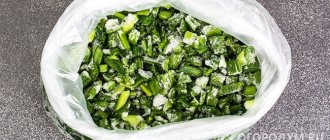After driving through deep ice holes, I was haunted by the thought that in my bridges it was not a transmission but jelly, yogurt made from water and oil, but at the same time there was no extra 3 rubles for 3 liters of normal oil. Yes, and the toad was choking after 6000 thousand mileage, but what if everything is ok, and I’m just wasting water in vain. I decided to monitor the Internet on the topic of whether it is possible to remove water from the oil and pour this resurrected miracle back into the bridges. The idea turned out to be not new, but most of the solutions are quite messy or expensive to implement, except for one. I'll tell you about him. Its name is Freezing settled water from oil. It's simple - drain the spoiled oil, let it settle, more is better. The water will go down, the oil will rise to the top. We put this thing in the freezer overnight, in the morning we pour the thick, purified oil into a container, and throw away the ice from the frozen water, that’s it, profit. And if we drain it through a fine filter, then, in theory, what did not settle, but remained in the oil, for the most part will remain on this mesh in a solid but rapidly melting state, so time matters here. We've read it, now let's try it.
We will need a 12mm hexagon for plugs in bridges, a convenient container, a funnel with a filter mesh, a syringe for filling oil (for a homeless person you can use at least 20 ml, but then you need to dial it in and give it about 140 times, I had 100, you will need to repeat the operation about 29 times) and a liter of any oil with the characteristics declared by the factory for topping up (I took the option from TNK for 450 rubles, since the oil won’t be perfect anyway, so you won’t really spoil it). Looking ahead, I’ll say that from the kind of oil that was pouring into the light, it was clear that if there was water there, it was so little that I wouldn’t freeze a damn thing out.
Yes, it’s darker from the back than from the front, but there are no silver or pink shades, much less yoghurtiness in sight, you can just see that it worked, you can fill in a liter of new oil, spreading it in the proportion of 2/3 back 1/3 forward, and the rest is that they leaked. I still let it sit for 8 hours, but since there was nothing, nothing sank to the bottom, no color changed underneath, no signs of water. Well, maybe some guano has gone down to the bottom, so it’s still not superfluous, I think.
The refreshed oil returned to the bridges, leaving about a liter of replaced residues from the drained waste. Although I was glad that there was nothing critical, the thought that the experiment was not completed did not give me peace. Therefore. We take a convenient container left over from the new oil, pour the waste oil into it and add about 15% of the volume of the filled oil with tap water into the bottle (well, like after a harsh standing on the water)
I honestly then walked around and shook this thing for about five minutes, so that everything would mix for sure, as would happen in bridges. Closed the lid and left to settle overnight. In the morning, I carefully moved the “test tube” into the freezer of the refrigerator and gave it 4 hours to freeze.
Then, at a brisk pace, I took the experimental composition out of the cold and began to pour it through a funnel with a mesh into another container. So, the oil has drained, but where is the ice? On the ball, I hit the floor with a bottle and lo and behold, there was actually ice there, and a lot of it, it couldn’t fit through the neck. Knowing that time was not on my side, I applied the ax several times and released the ice out, and small pieces, by the way, also remained on the mesh of the funnel, there weren’t many of them, but still.
There are all sorts of situations that happen in life: for example, vegetable oil is mixed with water, or liquid gets into the engine. Separating oil from water with your own hands is easy and simple: remember the school chemistry course, stock up on filters, tubes and absorbent agents.
How does water get into the engine?
Water may enter the engine as a result of flooding in the engine compartment. Water, entering the vehicle's crankcase, begins to mix with the engine oil entering the BC and to the engine cylinder head through the lines of the internal combustion engine lubrication system.
Interesting materials:
How to remove the label from a closed bottle of champagne? How to fillet a duck? How to remove tile adhesive from floor? How to remove a circle from an angle grinder with a key? How to remove the cover of ZTE Blade a610? How to remove a sticker from a windshield? How to remove oxides from stainless steel? How to remove film from a wooden door? How to deregister a motorcycle after sale? How to remove a drill bit from an impact drill?
The essence of the mixture
These two liquids do not mix with each other. From a school chemistry course, many will remember that the combination of water and fats is called an emulsion. Additives are always required for the diffusion of substances - they are called emulsifiers.
When mixed with water, the oil layer appears on top, since it is a lighter substance. Due to its greater density, water sinks. Separating the two products is not difficult.
Efficiency of cleaning measures
The ingress of a small amount of oil and the prompt action to neutralize it provide a 100% result in cleaning the well. If possible, you should pay attention to the composition of the oil. As it passes into the aquifer, it is broken into fractions, some easier to remove, others more difficult.
A small example from life: an oil film was discovered in a well, the owner did not call a team from the company servicing the wells, but went to get advice on the Internet. A few days later the film disappeared. Science has proven that not a single substance appears from nothing and disappears into nowhere. The oil just started to disintegrate and remained in the water. Its presence can only be detected by extensive chemical testing of water samples.
After completing the cleaning and good water tests, you need to flush the water supply. Household appliances (boiler, washing machine) will have to be washed thoroughly.
Pathways of oil pollution
In 9 cases out of 10, an oil film in the well is the result of contamination with petroleum products. For a beautiful rainbow spot to spread on the surface, a small amount of oil is enough, for example, from a failed submersible pumping equipment. Therefore, if there is a pump in the well and water comes out with stains, it must be urgently removed and examined for leaks.
An ordinary gasoline lighter that fell out of a pocket while its owner was looking inside the mine can spoil the water. There are cases when neighbors polluted the water after a conflict situation or simply because there was nothing better to do. Unfortunately, the spirit of free sabotage is ineradicable.
Purifying water in a well after local contamination takes a long time, but it is possible. If the contamination occurred as a result of a large-scale oil spill that affected the feeding aquifer, there is only one way out - to dig another well or drill a well.
Some types of bacteria that multiply in the warm and humid environment of the well can also produce an oily film. This option should not be excluded. Oil products can be washed out with water from reinforced concrete rings coated with technical lubricant or a bottom filter assembled from the first stones and cobblestones that come to hand.
The WHO sanitary standards for the quality of drinking water do not allow the admixture of petroleum products in it; the domestic SanPin allows a total maximum permissible concentration of 0.1 ml/l. A person feels the presence of petroleum products in water with a concentration of about 0.3 ml/l
The structure of concrete is rough and porous; after a single contact with oil, it will release it into the water for a long time, so technical rings cannot be used for drinking wells.
An oil film and unpleasant odor appear after breaks in old septic tanks and sewage pits. Another way for oily stains to appear is through the use of paints, stains and impregnations. When painting a well house, they accidentally drip or flow down the wall, and then form a film and give a specific taste to the water.
Do's and Don'ts
In turmoil and frustration, the owners can complicate the situation even before the team of craftsmen arrives. The first mistake is to try to collect the oil with a bucket or pump it out with a pump. The film floats on the surface, meaning the water is partially contaminated. And when the level in the well decreases, the oil falls on the walls of the shaft, is absorbed and covers a large area.
Contact with the oil film is undesirable, especially if it is not clear what kind of pollutant got into the well. Therefore, all work must be performed with thick rubber gloves.
It is good if the trunk is lined with smooth plastic pipes, which are easier to clean, but to wash the rough surface of reinforced concrete rings, you will have to try. This will increase the time of cleaning work and increase its cost.
In wells with automated water lifting, first of all you need to check the serviceability of the pump. The equipment contains a small amount of machine oil, which can leak if it breaks down. This will help determine the cause of contamination or reduce the options for contamination of the well.
It is necessary to immediately turn off the autonomous water supply from the well. In the best case, the oil has not yet had time to cover the walls of the pipes; in the worst case, the system will have to be flushed or replaced.
Fighting oil film with biological products
Nature has a solution for oily water pollution. These are special microorganisms that process oil, breaking it down into less toxic substances. Based on them, preparations are produced for the purification of water bodies, land plots and industrial wastewater.
At home, the drug is applied to the surface of the water in the form of a suspension. The temperature of the environment is from 5 to 40 C. After absorption of substances that caused the appearance of an oil film, bacterial proteins and non-toxic waste are released. Compared to mechanical methods, which cannot completely remove the oil film, microorganisms win by a large margin.
We also suggest that you read the article on well disinfection here.
Handy methods for collecting oil film
The source of the oil problem has been found, now you need to decide what can and cannot be done next. It is strictly forbidden to lower the water level in the mine. The point is the physical characteristics of petroleum products and synthetic oils. They are lighter than water and float on the surface, and if the water is pumped out, the film will cover the open walls of the rings. As a result, a much larger area will have to be cleaned.
The most affordable way is to use available adsorbents. Plain paper, dry clean sawdust, peat and newspapers are suitable for this. The sheets are laid out on the surface of the water, and then carefully removed by one edge. The water will drain, but the oil particles will remain. Sawdust also absorbs oil, they are placed on top of the film, and then removed and disposed of. This activity is tedious, but gives noticeable results.
The bulk of the spill can be collected using a surface pump. A bucket-type device is built next to it, which is sunk so that water from the topmost layer flows inside through the edges. You need to work carefully, pour the pumped out liquid into a technical well. Mechanical cleaning will allow you to collect up to 80% of the oil film. Used adsorbent materials must be burned.
The problem of pollution of the World Ocean with petroleum products is critical. Every year, as a result of accidents and spills, 10,000,000 tons of oil enter the water. This amount is enough to cover a third of the Earth's water surface with an oil film.
To remove any remaining oil from the pores of the rings, use a pressure washer while pumping out the water. Alcohol is suitable for processing if it is effective for a specific type of petroleum product.
A positive result from self-collection of the oil film is possible if the source of contamination is correctly identified. The reason to call a team of professionals will be the fact that after labor-intensive collection and cleaning of the well, stains and stains continue to appear.
Butter. Small butter factory.
The purpose of this operation is to remove excess water from the oil if the oil is washed, or churning if the oil is not washed, and also to give the oil the desired density and compactness.
The main rule of this operation is the requirement to touch the oil as little as possible, and touching the oil with your hands is absolutely not allowed. Then it is very important that the oil is not smeared during the entire processing time, for which it is necessary to avoid any lateral movements when pressing the churning.
It is best to process or extract oil using automatic oil processors. There are quite a few of them, but the basic principle of their design is the same. All of them are a convex or concave rotating circle, along the radius of which there is also a rotating corrugated shaft. Once placed on the circle, the oil passes between the latter and the grooved shaft and is squeezed out.
The best oil processor. Its structure is as follows. The rotating round squeezing table is driven into rotation using a system of gears that simultaneously drive the grooved roller. The table has a surface concave towards the center, and in the very center of the table there is a drain hole. The grooved shaft has the shape of a truncated cone and is strengthened in such a way that it rotates at the same speed as the table and, moreover, is always spaced in all its parts at the same distance from it.
Rice. 6. Manual oil processor.
Without touching the oil with your hands, the latter is laid out directly from the strainer onto the round table. However, the oil processor must be thoroughly washed first. For this purpose, all parts of the oil processor that come into contact with the oil must be boiled with boiling water and wiped with a good herbal brush. The oil processor is then cooled using cold ice water. The better the table is cooled, the better.
The squeezing operation itself is carried out in such a way that the oil passed once under the roller is collected into one lump again and again passed under the roller. Passing under the roller, the oil acquires a corrugated surface. Then, using beech spatulas, the butter is rolled into a roll, which is turned across the table. Inside the roll there are voids, or rather, passages that look like tubes and correspond to the indentations of the shaft. Through these passages, the water squeezed out of the oil is driven out.
Rice. 7. Palm spatula, beech spatula, beech knife.
With very little experience, the master rolls and transfers the butter so quickly that the work can go on non-stop. You should stop squeezing when churning does not flow out of the oil when passed under the roller. However, you should not squeeze the oil completely dry, because then it acquires an unpleasant, greasy dullness. Usually, oil is considered to be completely pressed when, without churning, it becomes covered with a dew-like coating and leaves the same coating on the oil processor’s table. You need to pay especially serious attention to this, since even passing it under the roller one extra time sometimes means greatly deteriorating the quality of the oil.
Salting butter. In some cases, when oil has to be stored for a particularly long time or when it has to be shipped over very long distances, it is necessary to preserve the oil with salt, or salting. This operation must be combined with a pressing or processing operation.
To do this, the oil that has just been removed from the churn, even before it enters the oil processor, is weighed, and then for each pound of oil, depending on need, from 1 3/4 to 2 1/4, and on average 2 pounds of salt, is weighed. Salt should be used only from self-settling salt; Bakhmut salt is very suitable for this purpose. Before weighing, the salt must be sifted into a strainer so that any specks accidentally mixed into the salt do not get into the oil.
